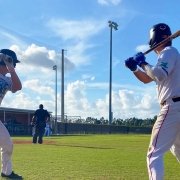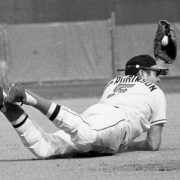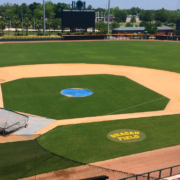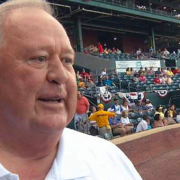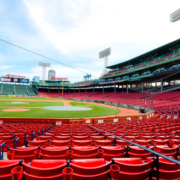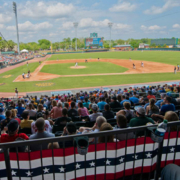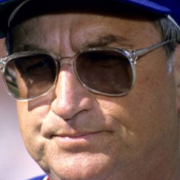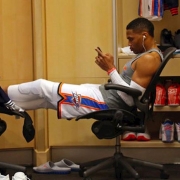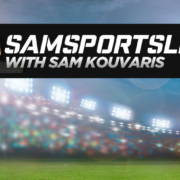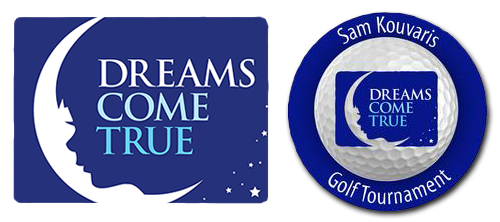Wood Bat Baseball in Town
There’s a familiarity when you walk onto a baseball field. You don’t even need to open your eyes to know where you are. The smell of cut grass, the feel of dirt under your cleats and the energy of a dugout the comes from baseballs and gloves in their own random, organized spaces.
The familiar sound of a baseball being hit by a bat would easily confirm your belief that you couldn’t be anywhere else but on the diamond. That sound in the last three decades became a hard “ping” of aluminum or a “thwack” of ceramic against a horsehide covered sphere.
If you wanted to hear the “crack” of the bat, so mythologized through the history of the game, the Baseball Grounds was the only house of refuge.
This summer, Atlantic Coast High School and J.P. Small ballpark added that “crack” of the bat to the ambient sound of a game being played there thanks to the new Coastal Collegiate Baseball League.
The brainchild of Chris Lein, who quickly called his friend Fran Delaney, the Coastal Collegiate Baseball League is giving college players a chance to hone their skills and hopefully, take the next step in a wood bat summer league.
“We’re the fifth wooden bat summer league in Florida,” said Lein who has more than forty years in pro baseball as a player, coach and scout. “My son played in one of the South Florida leagues the past two summers. And I wondered why there wasn’t anything up here.”
“It’s all about development,” Delaney, who has more than twenty years’ experience as an umpire, explained. “We have guys from Junior College or smaller colleges, these players are looking for that next step. This league can help those guys out.”
Both of these “baseball lifers” have full-time jobs. Lein as a financial advisor and Delaney as a “Customer Success Manager” for a software company. They’d been kicking around the idea of creating a wooden bat league in town for a couple of years. And despite the constrains of the pandemic, they got serious about it last fall.
“Sometimes I wonder why I picked up his call,” Delaney said with a laugh of his involvement thanks to Lein. Lein is officially the Commissioner of the league while Delaney is serving as the Vice President of Operations. In reality, both have handled everything from securing the fields, buying uniforms and lining the basepaths.
Lein contacted more than 1,400 schools with baseball programs around the country, letting them know there would be wooden bat, competitive, developmental baseball in Jacksonville this summer.
“Fran and I decided it’s not a fly by night thing,” explained Lein. “This area needs this ball. A lot of coaches already had their players set up to play somewhere. So, we started from scratch.
The local colleges couldn’t provide their fields this year because summer Covid issues. Coach Aaron Bass of Atlantic Coast said they could play all of their games there. But the city was very cooperative with JP Small, and they gave the CCBL a grant because they’re bringing guys from out of state.
Fifteen different states are represented among the four teams in the league. Half of the players are from junior college but there’s a sprinkling of Division One, Two, Three and NAIA players as well.
Going into his senior year at La Sierra University in Riverside, California, corner infielder Alex Ogletree is playing in the Coastal League in Jacksonville for a variety of reasons. Growing up in a military family, Ogletree was recruited to La Sierra while his parents were stationed in Italy. His parents are currently living in St. Johns County, but it was the baseball that ultimately brought him here.
“Guys here mature more quickly when it comes to baseball,” Ogletree said of the game here versus California. “Guys really know the game, know the nuance of the game earlier. In this league, the competition is phenomenal.”
Delaney’s career as an umpire has given him a close-up view of just how good baseball is in Florida and specifically in Jacksonville.
“The game here is faster. Guys here can play the game. They understand the game. That’s great for the players because it’s the coaches who have taught that. It’s impressive.”
The original thought was to have six teams in the local league. Pitchers are hard to come by though, so rather than water down the competition, they’ve started with four teams playing nearly forty games in eight weeks.
It’s $1,250 to join the league. Players pay for about four-fifths of their hotel on Baymeadows with the league picking up the rest.
“The goal is to have both sides of the balance sheet read zero,” Lein explained. “Uniforms, college umpires, college flat-seam baseballs from Rawlings and good fields. We wanted some legitimacy immediately.”
They’ve also gotten about twenty restaurants on the southside to offer discounts to the players. So, for about $2,000, players can get plenty of at-bats, pitchers can get some innings, and one more thing.
“First off, we don’t want anybody get hurt,” Delaney explained. “And we want guys to work on what they’re working on. But we also want them to enjoy themselves. Enjoy Jacksonville, go to St. Augustine, go to the beach.”
The next generation of major league players will have grown up rarely taking a swing with a wooden bat. This gives current players with a professional dream a chance to make that transition.
Former Major League pitcher John Wasdin is one of seven “ambassadors” the league is using to help teach that transition.
“Hitters need to really learn how to hit again, and pitchers have to re-learn how to pitch with a wooden bat,” the former first round pick out of Florida State said. “There’s a learning curve on how to pitch and how to hit with wood. The goal is to play at the next level so we’re looking for development.”
Wasdin’s time as a player and coach in professional baseball in Major League Baseball and in Japan showed him that command of the strike zone is the key to success on the mound. That’s what he’s trying to help with here. A hitter standing at the plate with a wooden bat is a very different challenge. Pitchers need to pitch inside.
“Typically, as a pitcher we’re looking for command of the strike zone,” Wasdin explained. “With an aluminum bat you can get a hit on an inside pitch but with the wood bat, we’re looking to see if guys can have command over the plate Inside and outside. A pitching coach wants a guy who can pitch, not just throw it a hundred and walk the world.”
Kyle Houts is an assistant coach at Iowa Lakes Community College and is spending his summer here in Jacksonville coaching one of the teams in the Coastal Collegiate league. He says the league has been good, especially for the first year. And he expects the best form of advertising, word of mouth, will only make it better.
“The players are getting extra reps that are necessary, especially from the pitching side,” he explained. “Guys are getting reps they didn’t get during the season.”
Working on his skills as a hitter with the wood bat is only one of the things Ogletree is trying to accomplish this summer. He’s working on his mental game.
“Mentally going into my senior year, I really want to be an example for younger guys coming in,” he said. “I wanted to mature emotionally. I’m trying to stay true to that. I’ve learned some things about myself and myself as a player. I’m not trying to ride the emotional rollercoaster.”
Playing in Florida is a draw for the league. About a third of the players are from the Jacksonville area and the rest, players and coaches, have come in from elsewhere.
“Jacksonville is a great baseball town, great baseball minds, great facilities,” Wasdin added.
“Living here is great and easier,” Ogletree agreed, comparing this league to others he’s played in during the summer. “The amenities are better. Gas is cheaper. The league is accessible across the board.”
“Jacksonville is an attraction for sure, Delaney agreed. “We’re not South Florida and we’re not Orlando. I’ve seen a lot of games around the state, this is one of the places that has the best overall team baseball.”
Lein plans to add a sales director to the staff for next year after building the league’s resume this season.
“We’d like to have six teams, add more pitching and add more fields,” he added. “We hope to be at Episcopal and we’ll talk to Bishop Kenny and the local colleges. That’s prime Jacksonville real estate, We’d like to talk with the Baseball Grounds about playing there. This thing is going to go.”
“I learned that’s there’s a lot of baseball talent in this country!” Delaney said of the first year. “We just wanted this to happen and to hear people say they couldn’t be enjoying it more is so gratifying. We want Jacksonville to be identified with this. We want guys to want to come play here. We want some of our local guys who go off to play out of town, we want them to come back and bring some teammates with them.”

